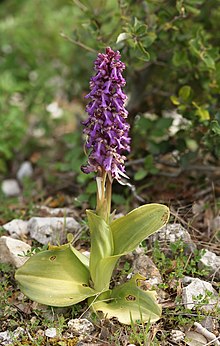Himantoglossum robertianum
| Himantoglossum robertianum | |
|---|---|

| |
| Scientific classification | |
| Kingdom: | Plantae |
| Clade: | Tracheophytes |
| Clade: | Angiosperms |
| Clade: | Monocots |
| Order: | Asparagales |
| Family: | Orchidaceae |
| Subfamily: | Orchidoideae |
| Genus: | Himantoglossum |
| Species: | H. robertianum
|
| Binomial name | |
| Himantoglossum robertianum (Loisel.) P.Delforge
| |
| Synonyms[2] | |
| |
Himantoglossum robertianum is a species of flowering plant in the orchid family (Orchidaceae) native to the Mediterranean Basin.
Description
Himantoglossum robertianum is a bulbous plant.[3] It flowers from January to April.[1][4] The bulb is edible when cooked.[1]
Distribution and habitat
Himantoglossum robertianum is native to the Mediterranean Basin and is found in Portugal, Morocco, Spain, Balearic Islands, France, Italy, Sardinia, Corsica, Algeria, Libya, Yugoslavia, the Greek mainland, the Aegean Islands and Crete, Anatolia and Cyprus,[5] and recently (March 2023) found in Israel.[6] It is found in short, poor grassland, garrigue, scrub, and open woodland. It prefers dry to moist, alkaline and calcareous substrates.[4][1] It can be found up to 1,700 m (5,600 ft) altitude.[1] The plant was found growing in Britain for the first time in 2022. It is believed that its distribution range is expanding due to the effects of climate change.[7]
References
- ^ a b c d e Rankou, H. (2011). "Himantoglossum robertianum ". IUCN Red List of Threatened Species. 2011: e.T175926A7145415. Retrieved 17 December 2020.
- ^ "Himantoglossum robertianum (Loisel.) P.Delforge". Plants of the World Online. Royal Botanic Gardens, Kew. Retrieved 15 May 2022.
- ^ "Himantoglossum robertianum" (PDF). Flora Iberica. Retrieved 17 December 2020.
- ^ a b "Barlia robertiana (Loisel.) Greuter". Flora-on. Retrieved 17 December 2020.
- ^ "Himantoglossum robertianum (Loisel.) P.Delforge". Catalogue of Life. Retrieved 17 December 2020.
- ^ "Himantoglossum robertianum (Loisel.) P.Delforge". Catalogue of Life. Retrieved 12 March 2023.
- ^ "Giant orchids found growing wild in UK for first time". TheGuardian.com. April 2022.



